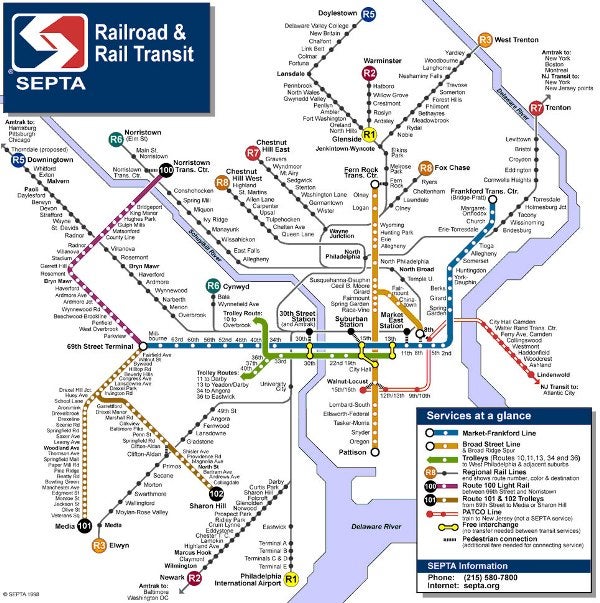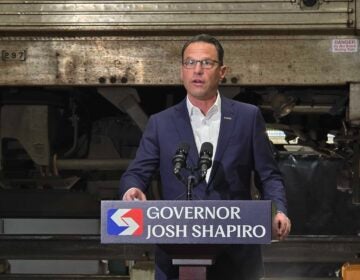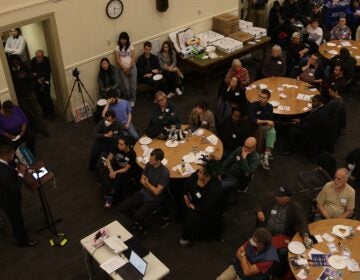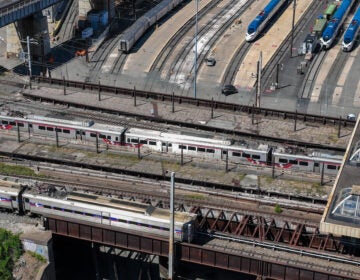SEPTA to change regional rail designations

Get ready to say good bye to the R8 regional rail line and say hello to the Fox Chase and Chestnut Hill West lines.
SEPTA sounds like it’s settling down on a plan to phase out the regional rail numbers in use since the Center City Commuter Connection tunnel was opened in the 1980s.
Starting July 25, lines will be named after their station terminals, Harry Garforth, SEPTA’s manager of rail planning, told a Feb. 2 meeting of the regional rail subcommittee of the Citizen’s Advisory Committee.
The colors associated with each line — the R8, for example, is orange on schedules and on system maps — will also be removed, he said.
Though Garforth went into great detail about these plans in the course of a several-hours-long meeting and responded to questions, when SEPTA spokesman Gary Fairfax was contacted the next day for more details, he said that Garforth got ahead of himself in indicating that the final decision had been made.
Fairfax said that the authority is “strongly considering” this option but that general manager Joe Casey has yet to sign off on the plan.
In his presentation, Garforth indicated that the decision had already been made.
SEPTA hopes the change will eliminate confusion for area visitors and infrequent riders, who sometimes board the wrong train because they don’t understand that each line travels to two different directions.
The authority had been discussing the change for some time. Other ideas batted around by SEPTA officials were to give each line a name, like the New Jersey Transit model, or a letter.
The change also moves SEPTA away from a European-style regional rail model that emphasizes the possibilities of through-service beyond the Center City tunnel and into outlying neighborhoods and suburbs. Schedules made after the change won’t make reference to the other side of the old lines
This, Garforth said, will allow SEPTA to route its trains more efficiently and will acknowledge the reality that more and more trains change lines or head to the depot as they pass through Center City.
The hoped-for market of through-riding commuters never materialized after the tunnel was completed, and most through-riders today travel to the Philadelphia International Airport and Trenton. An analysis of Delaware Valley Regional Planning Commission survey data shows that about 100 passengers a day travel to Trenton from R7 Chestnut Hill East stations, according to senior transportation planner Greg Krykewycz.
He warned, though, that the number was based on small sample sizes.
Only 33 percent of weekday trips travel along the same line past Center City, according to an Inquirer article.
Garforth said last night that percentage would probably decrease over time, though he would like to look at new through-train destinations for off-peak trains after the lines have been separated.
So for riders traveling from Wayne to Doylestown on what is now the R5, not much should immediately change — though SEPTA won’t say on its paper schedules which trains will continue on past Center City. Over time, though, SEPTA will be able to reroute trains along different lines, potentially ending the one-seat ride between those two stations.
The change has been vociferously opposed by University of Pennsylvania engineering professor Vukan Vuchic, who helped design the current regional rail system. In an earlier interview, he said that SEPTA never made enough of an effort to promote through-service as an option for area commuters.
To mitigate the effect on riders who are interested in through-service, CAC members suggested to Garforth that SEPTA include train destinations after they leave Center City. That way, riders will be able to plan their train transfers more easily.
Other members were also concerned about the effect the changes would have on institutions — especially area colleges — that market SEPTA on the basis of the regional rail lines that serve them.
Matt Mitchell of the Delaware Valley Association of Rail Passengers, a transit advocacy group, suggested that disconnecting the lines from each other gives SEPTA the opportunity to update its train routing procedures to take into account current commuting patterns.
Unclear is what SEPTA would call lines which have two popular terminals, like the R5 Paoli/Thorndale and the R3 Media/Elwyn. Fairfax said it would be “premature” to comment because no final decision has been made.
Contact the reporter at campisi.anthony@gmail.com
WHYY is your source for fact-based, in-depth journalism and information. As a nonprofit organization, we rely on financial support from readers like you. Please give today.






